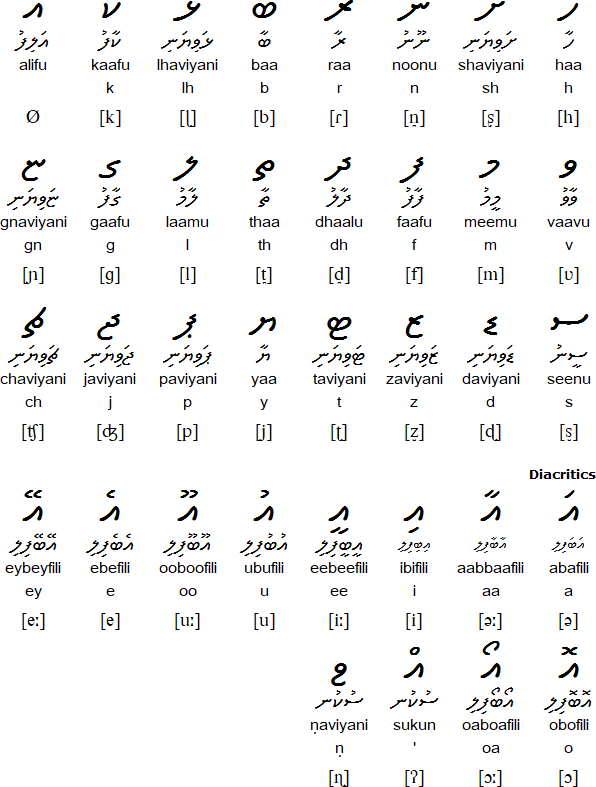The Arabic abjad has its influences throughout many parts of the world. From the Urdu script for, well, Urdu, and Persian script for Farsi, to the Jawi script for Bahasa Melayu, there are many letters added to the 28 original letters of Arabic from these respective languages. However, these scripts will not be the focus of this week’s coverage. Instead, this writing system does look like Arabic, but in fact, is actually an abugida (much like Devanagari).
The language using this is an Indo-Aryan one, which, I know, hardly narrows things down. What could help in specificity though, would be the fact that this language is primarily spoken in the country of the Maldives. Yes, the country traditionally renown for its diving spots, low lying atolls, and honeymoon resorts is the home to the language with this writing system. This is Maldivian, also known as Dhivehi, spoken by around 350,000 people mainly in the Maldives, and Minicoy Island in India.
Being the southernmost Indo-European language (before European colonisation), Dhivehi is closely related to Sinhala, but is not quite mutually intelligible with it. With influences from languages like Arabic, Persian, Portuguese, Hindi-Urdu, and English, Dhivehi has developed to incorporate words from these sources into the language. What Dhivehi gave the English language included the words “atoll” and “dhoni”, the latter meaning a “vessel for inter-atoll navigation”.
Dhivehi today uses the Thaana writing system, but it was not always the case. Prior to this, Dhivehi used the Dhives Akuru script, an abugida related to writing systems like Tamil, Malayalam, and Sinhala. But somehow, since the 18th century, a move towards Thaana was recorded, with the earliest inscriptions dating back to the late 16th century in Northern Miladhunmadulu Atoll.
Thaana did not stay all the way through in recent history though. For a brief period in the 1970s, the Maldivian government approved a Latin transliteration for the Dhivehi language, to ensure its compatibility with the then newly imported Telex machines. However, the Thaana script was reinstated just a couple years later in 1978, although the Latin transliteration could still be used in parallel.
What makes the Thaana script unique is not just its rather loose resemblance to the Arabic script, but also its other characteristics. The first distinction to be made from Arabic is the actual lack of cursive connections between the letters in Thaana, contrary to what you might think when you see written Thaana. Consisting of around 24 letters, the Thaana script features letters of Arabic and Indic origins, but not just any plain letter. The first nine letters of Thaana actually derives from the Arabic numerals from one to nine, and so are the next few letters, but from Indic origins.

But, what of the remaining letters? Well, those would be derived from actual Arabic letters. Examples include the letter vaavu, which is derived from the letter waw in Arabic. Looking at the vowel diacritic markers, we find several similarities to Arabic. One of which is the fatha, which denotes the vowel a. The kasra, as used in Arabic, is also used in Thaana to denote the vowel i. Interestingly, Thaana has adapted the Arabic sukun to be used as a glottal stop marker. However, this differs from Arabic, which mainly uses it to show that the consonant it is attached to does not carry a vowel. Going on a slight stretch, we might see some similarities in the use of the damma in both Arabic and Thaana to write the vowel u. However, the double kasra and fatha in Thaana only lengthens the vowel sound, unlike in Arabic, which carries an -n sound at the end of the vowel.
However, the order of letters in the Thaana alphabet does not quite match those in the Indic nor the Arabic systems. There is not really a backing logic behind this alphabetical order, leading to hypotheses that the script was purposefully scrambled up to keep the writing system secret from islanders. While originally used to write fadinta incantations, which included some Arabic quotations, Dhivehi-speaking men who were very likely versed in these sorcery things, realised the benefits of adapting this writing system to write Dhivehi, and so, Thaana gradually entered use in Dhivehi.
Among these letters however, the letter Ṇaviyani has fallen out of use. Originally used to represent the retroflex “n” sound [ɳ], the use of this letter has been abolished in official Maldivian documents in 1953. This, though, is not the only retroflex letter abolished — letters like Lhaviyani (ޅ), Daviyani (ޑ) and Taviyani (ޓ) were also abolished alongside in 1953, but the official reasons for such a move are unclear. Despite this, the Ṇaviyani continues to be used in some traditional books, and the Addu people who still have the sound in the Dhivehi language variant they speak. So while you might not find the Ṇaviyani in places like Malé, the capital of the Maldives, on Addu Atoll, you would find it used in texts like songs and poetry.